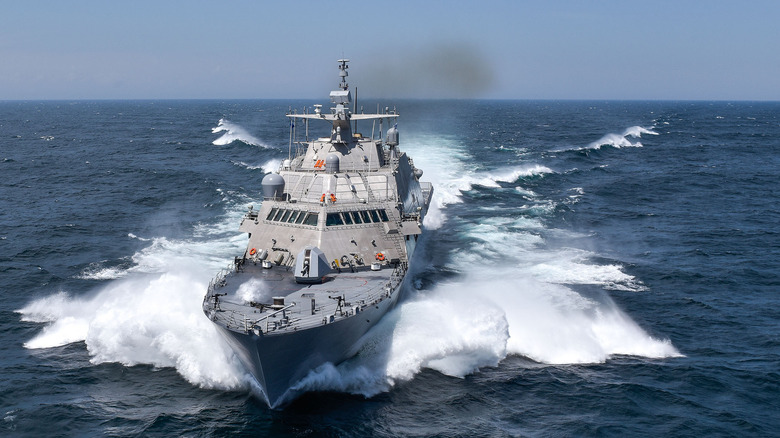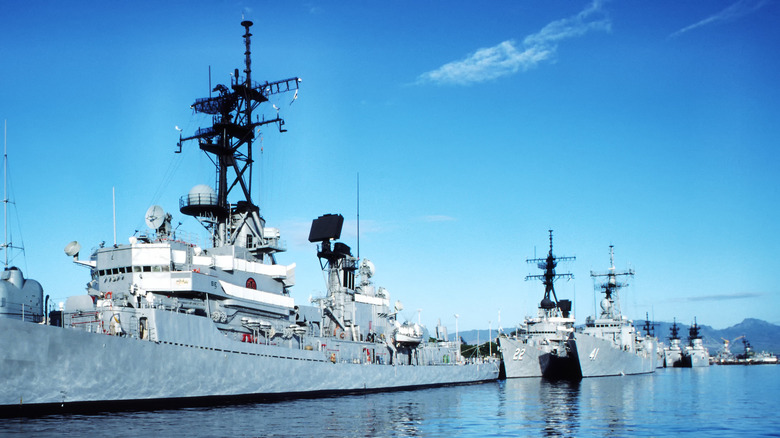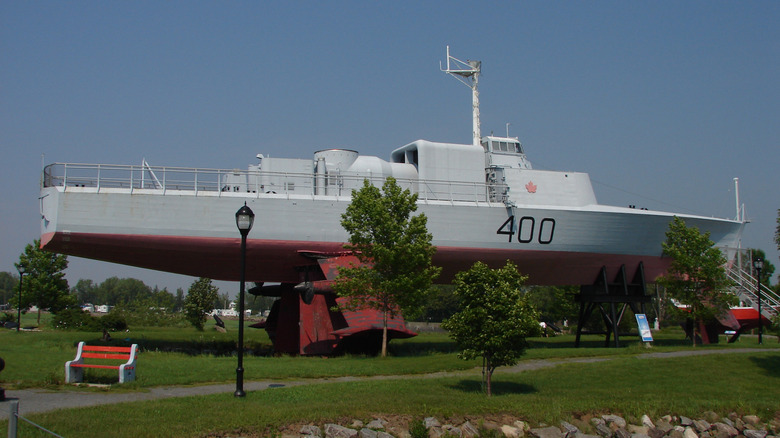What Is The Top Speed Of The Fastest US Navy Ship In Service In 2025?
Several U.S. naval ships are capable of reaching record-breaking speeds. As of this writing, the fastest U.S. Navy ship still in service is the Freedom-class littoral combat ship (LCS). Officially, it's "40+ knots," the U.S. Navy likely withholding its top speed for national security reasons. Unofficial sources, such as the National Interest, cite 47 knots as the Freedom-class LCS's speed ceiling — that's just over 54 miles per hour.
Of course, whatever the true top speed for the LCS may be, it's certainly far from the top speeds of the fastest motorboats ever built, which can reach hundreds of miles per hour. However, naval engineers are tasked with balancing speed and nimbleness with a ship measuring roughly 400 feet long and over 3,000 metric tons in weight.
The U.S. Navy commissioned most Freedom-class LCSs between 2010 and 2015, with about 11 to 14 ships in service at any one time. But the class hasn't been free of problems. The Freedom-class LCS USS Detroit was pulled from service for maintenance after its high-speed clutch bearings failed, and an official investigation revealed the entire class suffered from the same problem. In response, a speed limit for all Freedom-class LCS ships was imposed while the issue could be corrected, reducing its top speed to 34 knots. Apparently, thanks to the ship's faulty gearbox, 40+ knots was simply too fast.
LCS design and other fast U.S. ships
In 2002, the U.S. Navy created the LCS program to develop a fast and nimble combat ship. To encourage competition, the contract was made available to both Lockheed Martin and General Dynamics. Basically, both companies independently engineered ships that met the contract's specifications, so the Navy decided to split the contract between the two companies. The result was two classes of littoral combat ships. Lockheed Martin created the "Freedom-class" variant, which is still in service, while General Dynamics' "Independence-class" variant was nixed.
On July 29, 2021, the Independence-class's lead ship, the USS Independence, was "stricken" by the U.S. Navy. Yet, many of the specs between the two LCS variants are nearly identical. Like the Freedom-class LCS, the Independence-class variant had an official top speed "greater than 40 knots." Presumably, the Independence-class LCS could reach about the same top speeds as its counterpart, since both used the same propulsion systems. However, the Independence-class LCS was lighter, at 3,000 metric tons, but it was longer and used a different hull design.
Yet, while the littoral combat ships are the fastest U.S. Navy vessels currently in service, they aren't the fastest ever. The "hydrofoils" were fast attack patrol boats that the U.S. Navy held in its arsenal but rarely deployed in combat operations. In one exception, the USS Tucumcari, capable of reaching over 50 knots, was used in the Vietnam War. Another speedy hydrofoil was the Pegasus-class from the '70s, which was rumored to reach speeds of over 48 knots. The key to the hydrofoils' speed was the experimental design of the hulls, which used turbines to increase lift and reduce drag.
The fastest naval ships ever aren't from the U.S.
The United States certainly leads the world in naval power, but that doesn't mean the country holds the world record in every category. Several other countries developed ships that exceeded the top speeds of U.S. naval ships. Perhaps the fastest naval warship ever commissioned came from the USA's closest ally, Canada. Just like the attack patrol ships in the United States' experimental Pegasus-class, the Canadian HMCS Bras d'Or was an experimental anti-submarine ship that had a hydrofoil base to reduce its displacement and drag. The second HMCS Bras d'Or reached a record top speed exceeding 63 knots in 1969. (The first HMCS vessel with the name Bras d'Or was a World War II minesweeper.) Although it was eventually decommissioned in 1971 and never entered service, it remains the record-holder for the fastest warship ever used in a country's navy.
Other countries also developed extremely fast warships, as well. One contender for the speed record was the Skjold-class corvette out of Norway. Unlike the HMCS Bras d'Or, the Skjold-class corvettes were operational, and they actually earned a spot in the Guinness World Records for that distinction. It's not the first time Norway has stood out for its military technology; the indomitable Norwegian F-35s attract attention for their curious shapes.
The class contained several variants, though one ship in particular within the Skjold class earned the record. The P-962 KNM Skudd design can hit speeds exceeding 60 knots, which is about 69 miles per hour. Unlike the hydrofoil concept that gave the Canadian and U.S. warships their record speeds, the Norwegian design employed an "air cushion catamaran concept," which basically fills bags to pressurize the lower hulls and increase buoyancy and decrease drag — the key for speed.


